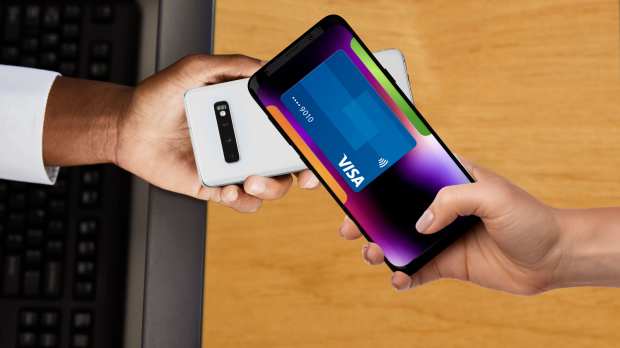Visa Tap To Phone Expands POS Acceptance For Retailers

The mobile point of sale (mPOS) landscape got more interesting today (Jan. 12), as Samsung has unveiled its Galaxy XCover Pro, an enterprise-grade smartphone that comes pre-installed with Visa’s Tap to Phone app. Tap to Phone enables sellers with Android phones to accept contactless payments without the need for additional devices or peripherals.
The evolution of commerce comes down to a single but powerful word: acceptance.
Acceptance, that is, on the receiving end of the payment methods that buyers – both people and businesses – want to use when transacting. And ever since the dawn of the smartphone and the apps ecosystem it unlocked, using those devices as acceptance points to expand retail’s footprint has been one of its most empowering use cases.
“Today, everyone is carrying a supercomputer in their pocket – they use it for both business and personal reasons,” Visa’s Head of Global Seller Product and Solutions Mary Kay Bowman told Karen Webster in an interview. “And for [Visa], the question has always been: How do we help businesses of all sizes use those devices to better serve their customers?”
Bowman noted that Tap to Phone leverages EMV’s underlying capabilities, the growing base of contactless cards in consumers’ wallets and the partnership with Samsung to allow sellers to tap into new retail sales opportunities, simply by downloading an app onto a mobile device they already use.
Tap to Phone isn’t a new initiative, but one that has been implemented across 16 live pilots in nine countries with strong contactless penetration. The partnership with Samsung is the first time the Tap to Phone software has been integrated into a device. According to Bowman, it is significant not only for the efficiency and sales opportunities it will create for sellers, but for what it signals about the evolution of retail, driven by innovation at the intersection of payments, software and technology.
Beyond retail, Tap to Phone is also intended for use cases in sectors undergoing their own transformations, such as healthcare, an on-ramp that the integration with the Galaxy XCover Pro will likely provide.
“Healthcare is going through a transformation, retail is going through a transformation – all of these areas are being transformed by digitization,” Bowman explained. “For Visa, the goal is to use our technology to open the door to different commerce experiences across all kinds of sectors with a simple, efficient and secure solution.”
Optimizing the Digital Transformation of Retail
The genesis of Tap to Phone, Bowman said, was as a means to more rapidly and efficiently expand the number of acceptance points for consumers toting contactless cards, with retail being a significant and primary use case right out of the gate.
Tap to Phone, she noted, is for the 90 percent of microsellers in emerging markets who don’t take digital payments of any kind, despite the fact that collectively, they represent about 40 percent of their home nations’ GDP.
But it’s also for the large and established retailers looking to minimize the need for buyers to wait in the traditional checkout line, as their partnership with Samsung reflects.
It’s also relevant for the direct-to-consumer brands born on the internet, which want a physical presence in a pop-up or small store of their own, or within someone else’s.
What will be built from this technology remains to be seen, Bowman noted – and they realize that what they see will vary. For department stores, she said, it might mean guiding the consumer differently through the retail journey, where they might have the ability to complete a transaction anywhere in the store instead of just at certain points of sale.
For a food truck in Southeast Asia, it might provide a way to eliminate cash dependence without forcing every customer to use the same mobile wallet. For a healthcare practice, it might mean finding a way to offer house calls that patients can pay for in real time.
As Bowman told Webster, the services offered will revolve around the specific customers for which they are trying to solve, as well as the builder tasked with creating a customer experience. What Visa offers, she said, is an ecosystem and capabilities at scale that can unlock a lot of doors when solving for a particular customer pain point.
The net result, she said, is a digital commerce ecosystem that will be changed greatly in the next few years by an upswell in active members and an influx of new ideas.
The Retail of the Future
The hunger for innovation spans the retail spectrum, from the food truck to five-star restaurants, and from boutique clothing shops to department stores that have been in business for decades, or even centuries. The common thread across all of them, Bowman noted, is a desire to reinvent the experience for their customers.
As Bowman explained, Tap to Phone’s role in shaping that reinvention is to make the process of getting paid – via the buyer’s preferred payment method – as easy as downloading an app. Partnerships with players like Samsung, she noted, have the potential to put that power into more hands faster.
The more interesting part of this announcement remains to be seen, as retailers and businesses across other verticals use this capability to shape the next era of commerce.
“I think one could very easily let themselves believe that digital payments acceptance is a done job, because everyone has access,” Bowman said. “We have learned that there are still underserved segments of the market across verticals and consumer segments in developed and developing markets. And we think there is a lot of transformation possible just by unlocking those underserved areas.”
